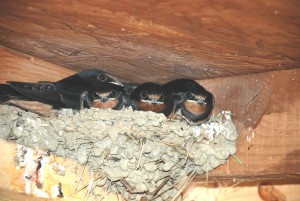 For many people the migrant bird of the spring means the swallow, particularly if they are lucky enough to have them nesting in a shed in the garden. The first sign is often the male, identified by its very long tail streamers, as it will sit patiently awaiting the female to turn up. The life story of the swallow is remarkable from a number of points of view such as the fact that almost half of them will return to the same nest site, often the same nest! To get back to us the swallow has to make an incredible journey of around 6,000 miles from their winter quarters in Africa and this includes crossing the vast Sahara desert. There is one compensation in that swallows are mainly insect eaters so they can feed on the wing. However, they still have to rest so do this at night-time, often at traditional roost sites such as reed beds. They travel around 200 miles a day and the trip as a whole will take about four or five weeks. At one time it was the swallow that led people to believe that they could not take such a long journey to Africa but hibernated for the winter under water. This came about because of the habit of swallows of roosting in large numbers in reed beds. The swallows set off for Africa before first light and some people saw them going to roost at dusk and then they just disappeared!
For many people the migrant bird of the spring means the swallow, particularly if they are lucky enough to have them nesting in a shed in the garden. The first sign is often the male, identified by its very long tail streamers, as it will sit patiently awaiting the female to turn up. The life story of the swallow is remarkable from a number of points of view such as the fact that almost half of them will return to the same nest site, often the same nest! To get back to us the swallow has to make an incredible journey of around 6,000 miles from their winter quarters in Africa and this includes crossing the vast Sahara desert. There is one compensation in that swallows are mainly insect eaters so they can feed on the wing. However, they still have to rest so do this at night-time, often at traditional roost sites such as reed beds. They travel around 200 miles a day and the trip as a whole will take about four or five weeks. At one time it was the swallow that led people to believe that they could not take such a long journey to Africa but hibernated for the winter under water. This came about because of the habit of swallows of roosting in large numbers in reed beds. The swallows set off for Africa before first light and some people saw them going to roost at dusk and then they just disappeared!
The reason swallows can be faithful to the same actual nest is the time and effort it puts in to make the nest in the first place. The nest is a combination of mud and saliva formed into the characteristic cup on the side of wall or on a beam and to make such nest needs around 1,300 trips to collect mud. I have seen a swallow nest on the outside of a house in Inverness, rather like a house martin, but this is very unusual. Studies have shown that whilst both male and female birds may build the nest the male only does about a quarter of the work involved and then leaves the female to incubate the four or five eggs. The female often chooses which male to mate with by the length of the male’s tail streamers which varies with age and condition. The range of food is almost exclusively flying insects but will also include moth caterpillars hanging from trees. A brood of young swallows, such the older chicks in the nest in the photograph, need around 6,000 insects a day.
Meanwhile, whilst the swallows are only just arriving and sorting out their nest sites other birds, such as the siskin, are already well into their breeding season. Many readers have commented on the lack of siskins in their gardens in this last winter and spring and the conclusion was that there was plenty of natural food to be found such as the seeds of spruce trees. Now, however, a few siskins have turned up in gardens as, for example, I can see juvenile siskins begging for food near a feeder outside my study window. Both the adult males and females are feeding them but tending to ignore them more and more so making them independent. Interestingly if you work out the time from laying the eggs, incubation and then feeding the chicks in the nest it means that the first egg would have been laid about the middle of March – an early date indeed. Books tell me that how early siskins start breeding depends on the abundance of the crop of spruce seeds.
Tags: highland wildlife
